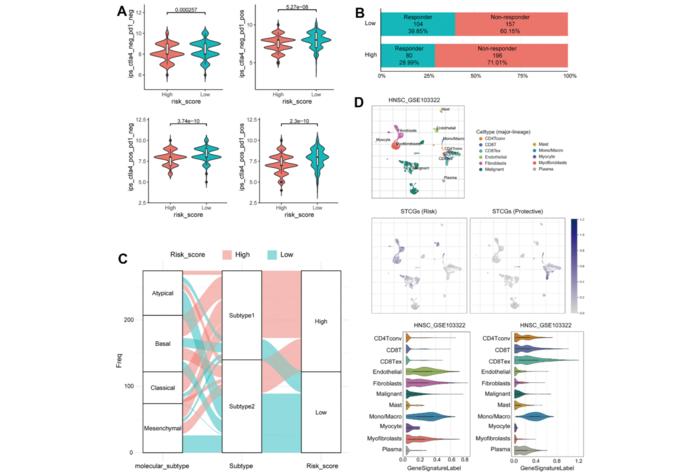“These findings provided evidence for the role of senescence in the tumor microenvironment […]”

Credit: 2024 Lee et al.
“These findings provided evidence for the role of senescence in the tumor microenvironment […]”
BUFFALO, NY- January 31, 2024 – A new research paper was published on the cover of Aging (listed by MEDLINE/PubMed as “Aging (Albany NY)” and “Aging-US” by Web of Science) Volume 16, Issue 2, entitled, “Prognostic significance of senescence-related tumor microenvironment genes in head and neck squamous cell carcinoma.”
The impact of the senescence related microenvironment on cancer prognosis and therapeutic response remains poorly understood. In this new study, researchers Young Chan Lee, Yonghyun Nam, Minjeong Kim, Su Il Kim, Jung-Woo Lee, Young-Gyu Eun, and Dokyoon Kim from Kyung Hee University, Kyung Hee University Hospital at Gangdong, and the University of Pennsylvania investigated the prognostic significance of senescence related tumor microenvironment genes (PSTGs) and their potential implications for immunotherapy response.
Using the Cancer Genome Atlas- head and neck squamous cell carcinoma (HNSC) data, the researchers identified two subtypes based on the expression of PSTGs, acquired from tumor-associated senescence genes, tumor microenvironment (TME)-related genes, and immune-related genes, using consensus clustering. Using the LASSO, they constructed a risk model consisting of senescence related TME core genes (STCGs). The two subtypes exhibited significant differences in prognosis, genetic alterations, methylation patterns, and enriched pathways, and immune infiltration.
“Our risk model stratified patients into high-risk and low-risk groups and validated in independent cohorts.”
The high-risk group showed poorer prognosis and immune inactivation, suggesting reduced responsiveness to immunotherapy. Additionally, the team observed a significant enrichment of STCGs in stromal cells using single-cell RNA transcriptome data. Their findings highlight the importance of the senescence related TME in HNSC prognosis and response to immunotherapy.
“This study contributes to a deeper understanding of the complex interplay between senescence and the TME, with potential implications for precision medicine and personalized treatment approaches in HNSC.”
Read the full study: DOI: https://doi.org/10.18632/aging.205346
Corresponding Authors: Young-Gyu Eun, Dokyoon Kim – [email protected], [email protected]
Keywords: cellular senescence, head and neck cancer, immunotherapy, microenvironment, single cell
Click here to sign up for free Altmetric alerts about this article.
About Aging:
Launched in 2009, Aging (Aging-US) publishes papers of general interest and biological significance in all fields of aging research and age-related diseases, including cancer—and now, with a special focus on COVID-19 vulnerability as an age-dependent syndrome. Topics in Aging go beyond traditional gerontology, including, but not limited to, cellular and molecular biology, human age-related diseases, pathology in model organisms, signal transduction pathways (e.g., p53, sirtuins, and PI-3K/AKT/mTOR, among others), and approaches to modulating these signaling pathways.
Please visit our website at www.Aging-US.com and connect with us:
- X, formerly Twitter
- YouTube
- Spotify, and available wherever you listen to podcasts
Click here to subscribe to Aging publication updates.
For media inquiries, please contact [email protected].
Aging (Aging-US) Journal Office
6666 E. Quaker Str., Suite 1B
Orchard Park, NY 14127
Phone: 1-800-922-0957, option 1
###
Journal
Aging-US
DOI
10.18632/aging.205346
Method of Research
Observational study
Subject of Research
People
Article Title
Prognostic significance of senescence-related tumor microenvironment genes in head and neck squamous cell carcinoma
Article Publication Date
21-Dec-2023




